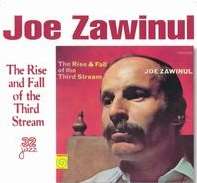The Rise and Fall of the Third Stream
| The Rise and Fall of the Third Stream | ||||
|---|---|---|---|---|
 | ||||
| Studio album by Joe Zawinul | ||||
| Released | 1968 | |||
| Genre | Jazz | |||
| Length | 30:37 | |||
| Label | Vortex Records | |||
| Producer | Joel Dorn | |||
| Joe Zawinul chronology | ||||
| ||||
| Professional ratings | |
|---|---|
| Review scores | |
| Source | Rating |
| Allmusic | |
The Rise and Fall of the Third Stream is an album by Austrian jazz keyboardist and composer Joe Zawinul, released in 1968. The title refers to the Third stream genre of music, melding classical and jazz.
Track listing
- "Baptismal" (William Fischer) – 7:37
- "The Soul of a Village - Part I" (William Fischer) – 2:13
- "The Soul of a Village - Part II" (William Fischer) – 4:12
- "The Fifth Canto" (William Fischer) – 6:55
- "From Vienna, With Love" (Friedrich Gulda) – 4:27
- "Lord, Lord, Lord" (William Fischer) – 3:55
- "A Concerto, Retitled" (William Fischer) – 5:30
Personnel
- Joe Zawinul - Piano and electric piano
- William Fischer - Tenor Saxophone and arrangements
- Jimmy Owens - Trumpet
- Alfred Brown - Viola
- Selwart Clarke - Viola
- Theodore Israel - Viola
- Kermit Moore - Cello
- Richard Davis - Bass
- Roy McCurdy - Drums
- Freddie Waits - Drums
- Warren Smith - Percussion
References
- ↑ Todd, Jim (2011). "The Rise & Fall of the Third Stream - Joe Zawinul | AllMusic". allmusic.com. Retrieved 19 July 2011.
An example of strings playing in a jazz context in the 1960s was pianist Joe Zawinul's 1968 recording titled "The Rise and Fall of the Third Stream". Zawinul collaborated with avant-garde composer William S. Fischer on this recording. The music consists of a series of extended compositions that do not follow standard jazz forms such as the blues or AABA form. Instead, each composition has its own formal structure. Even though the music on this recording sounds conventionally written out, Fisher actually wrote the music in graphic notation instead of conventional notation, which means that the players had to learn to read music that was timed by seconds instead of metric beats. Because the music was graphically written, there were many possibilities for interpretation open to the players. As well as composed music, there were places in the score that Fischer left open for Zawinul and other players to improvise.[1] The instrumentation for this album was unique in that Zawinul and Fischer chose to use three violas and one cellist for the string ensemble, thereby straying far from the prototype of a jazz string ensemble, which until this point had always included a violin. The violists were: Selwart Clarke, Alfred Brown, and Theodore Israel, and the cellist was Kermit Moore. In addition to the strings, the group consists of electric piano, tenor sax, trumpet, percussion, and drums. The music has a dark, rich sound because of the lower frequencies of these instruments. Instead of the high pitched and thin violin sound typically heard on other string jazz recordings (such as the Getz, Adderly, and Parker), the violas, cello, and bass give the music a lush sound. Even when the violas and cello occasionally play in their upper registers the timbre is still dark and intense. By listening, you can tell that all of the string players use a lot of arm weight in their playing, achieving sound that has a real core to it. The composition "Baptismal" is a good example of how the strings and other instruments interact. Fischer divides the ensemble into three groups that play off of each other. One group is the violas and cello, another is the rhythm section of piano, bass, and drums, and the third is the trumpet and saxophone. As can be seen in the following transcription, each group has its own role to play: the strings provide harmonic material played as long phrases as syncopated chords, the trumpet and sax play riffs that interrupt the flow of the main melody or play solos, and the rhythm section both keeps the pulse steady and plays solos.
This album by Zawinul shows that music with elements from the jazz world (ride rhythms on the cymbal, improvisation, typical jazz instruments, and a sense of swing) can be combined with elements from the classical world (composed music, prepared piano, typical string instruments, and large scale forms) to create a hybrid genre that can be categorized as jazz.
- ↑ The origins and development of the use of violins, violas, and cellos in jazz in the United States of America / Sonya Ruth Lawson, PhD dissertation 2003